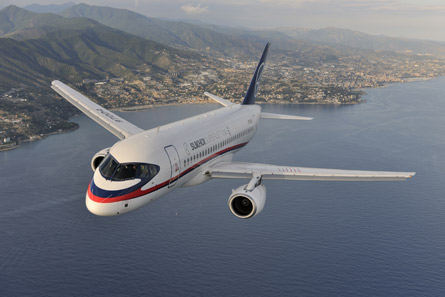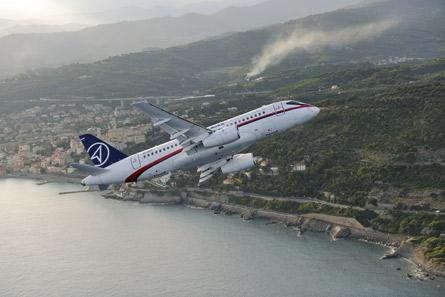Of all the new aircraft programmes under development today, possibly the most intriguing is the Sukhoi Superjet 100 regional jet. Not only is it the first civil airliner from a company known for iconic fighter jets, it is also a bold attempt to capture a global market by killing off a Russian legacy of fuel-thirsty machines with little or no appeal to Western operators unwilling to subject their passengers to Soviet-style creature comforts.
Knowing it had to do things differently to achieve these ends, Sukhoi has from the beginning embraced Western standards and technological inputs. But in what may prove to be a masterstroke of programme management, it has also built into the Superjet programme a Western partner to slay that most deadly of old-Russia dragons: poor aftersales service.
 |
|---|
© Superjet International |
It will be a year this month since Armenian carrier Armavia took delivery of the first serially produced Superjet. Another four went last year to Aeroflot, which has since taken two more and is expected to receive 10 this year.
But the big event of 2012 so far has been EASA certification of the aircraft and an uprated version of its PowerJet SaM146 engine, paving the way for Superjet's first test of approval outside of Russia and the CIS. Western launch customer Interjet, of Mexico, is set to take its first of 15 deliveries by year-end and a second in January 2013. Underscoring the significance of Western input, Powerjet is a joint venture between Russia's NPO Saturn and France's Snecma.
Flight International spoke to Carmelo Cosentino, president and chairman of Superjet International, the Venice-headquartered 49:51 joint venture between Sukhoi and Alenia Aermacchi set up to market the aircraft in Europe, the Americas, Africa, Japan and Oceania, as well as, critically, to provide customer service worldwide. Sukhoi, meanwhile, is handling sales in Russia and the CIS, the Middle East and India.
According to Cosentino, the Western sales effort has moved on since December 2010 when, in a much-scrutinised regional fleet upgrade competition, Alitalia opted to lease Embraer E-Jets rather than go with Superjet. However disappointing that result must have been to Superjet, Cosentino says the company respects Alitalia's decision, noting that they were concerned about agreeing to buy an aircraft that had yet to be certificated, and also had a more urgent delivery requirement than Superjet was likely to be able to meet. Today, though, neither of those concerns remains valid and there are "no constraints" on Superjet sales, he says.
Production is also being brought up to speed to begin satisfying the 168-aircraft backlog, which, as of end-2011, included 113 aircraft sold to Sukhoi customers and 55 notched up by Superjet International. Today, Sukhoi can deliver one aircraft per month, but by the middle of the year that rate will double and then increase to three per month by year-end, putting the company on track to deliver 23 aircraft in 2012.
As the Alitalia campaign highlighted, sales are easier when there is some in-service experience to highlight. The number of Superjets in service may still be in single figures, but the type has been in action for just shy of a year of scheduled service and Cosentino is confident: "We are very, very satisfied with the aircraft's behaviour."
FIRST IMPRESSIONS
Early indications of reliability are also positive, he believes. Like with any new type there are "growing pains" - one notable example was a March gear retraction incident involving an Aeroflot aircraft that led to all in-service aircraft being scheduled for modifications to eliminate a defect in the nose-gear door linkage. But Cosentino is not concerned about any impact on the sales effort. "The Superjet 100 is [proving to be] better than other and more famous airplanes, including those by Airbus and Boeing," he says.
 |
|---|
© Superjet International |
Customer feedback to date has been positive, he adds. As for passenger comfort, Cosentino believes Superjet to be "unsurpassed" in its class of aircraft and superior to Bombardier CRJs or Embraer E-Jets, thanks to five-abreast seating, or four in business class, and generous overhead space. Another nod to the programme's focus on meeting Western expectations came with Boeing's extensive input to the cabin layout.
Economics and performance have also been appreciated by both existing and potential customers, he says, highlighting the aerodynamics, which build on Russia's traditional strength in this field.
Ultimately, says Cosentino, Superjet meets Western standards on all counts: "In effect, it is not a Russian airplane - it's a state-of-the-art airplane."
That message is central to the marketing effort. Cosentino says Superjet recognises it must demonstrate superiority in order to take sales from established rivals Bombarier and Embraer. "We are very aggressive with the competition," he says.
Regionally, Superjet International sees Africa as rich with opportunity, and Cosentino hopes to be able to announce its first sale there "soon".
He's also bullish about building on Superjet's presence in the Americas, where Interjet should take its first delivery this year, followed by a second in January 2013. The low-cost carrier has 15 Superjets on order.
As regards North America, Cosentino calls that territory probably the world's "most sophisticated" regional jet market, but, he notes, it offers the prospect of large-volume orders.
Cosentino is also expecting the first CIS deal for the business jet version, which Superjet International is selling globally. Purchases of business jet versions have already been agreed by Switzerland's Comlux and India's Aviotech.
SALES PUSH
Price is a more complicated aspect of the Superjet sales push. Earlier this year, Sukhoi announced a 12% rise in its prices, to $35.4 million for the baseline aircraft and $36.2 million for the extended-range version. At the time, Sukhoi said increases were part of a "catalogue revision process and in line with the business plan", and stressed that it had held catalogue prices firm since September 2010, to reflect the global recession. In any case, the airframer said at that time, Superjet retains a 15% cost advantage over comparable rivals.
Russian price inflation has certainly been felt in its export markets over the past couple of years, but Cosentino doesn't see this as a particular problem for Superjet. The aircraft's cost reflects a mix of rouble, dollar and euro inputs, so Russian inflation itself is not an especial worry, as the overall picture is one of cost stability.
One aspect of the Superjet picture that is not complicated, at least in Cosentino's view, is the competitive environment. Superjet's rivals are the regional jet programmes of Bombardier and Embraer, and that situation will not change even if Alenia Aeronautica and Sukhoi decide to develop a larger variant. Indications to date have pointed to a 130-seater, which would take Superjet up to the bottom end of the Airbus A320 and Boeing 737 size range, leading observers to wonder how the aircraft would fare commercially if it drew competitive fire from the duopoly players in the larger airliner category, who have in the past year raised the stakes with launches of re-engined versions of their narrowbodies.
But Cosentino is dismissive of this. The current Superjet 100, he notes, seats between 87 and 98 passengers, and while a larger version is possible - some customers like to operate a family of aircraft rather than a single type - it would "not be much larger" than the 100. A family only makes sense, he says, if it has "large synergies", particularly in avionics, cockpit, engines and major equipment.
In any case, he stresses, Alenia Aeronautica and its parent, Finmeccanica, are absolutely clear that "we have no intention to compete where Boeing and Airbus are well established. It would be very difficult to declare war there".
Alenia and Finmeccanica are solid partners to both major airframers. Cosentino underscores in particular the value the Italians place on their relationship with Boeing: Alenia supplies carbon fuselage barrels and horizontal stabilisers for the 787, and that partnership has decades to run.
Source: Flight International























